(Feature image: Postcard celebrating our Family of Nations (date unknown). Far from being ‘divisive’ or ‘irrelevant’, the Union Flag has been a unifying symbol for disparate peoples across the globe who formed one glorious Empire of Western (Anglo Saxon) Civilisation. Undermining the symbols of this tradition, as well as defaming the foundational peoples that gave that civilisation life (as leftists and other radicals are want to do) is to assault the civilisation itself.)
With great dismay, we have again seen the cast of usual suspects revising what should be one of our most treasured national symbols – our national flag. However, on this occasion, as a garnish to top the usual boring diet of liberal social commentary, we have a politician who displays particular ignorance with regard to his culture and the deeper traditions of Australian identity, especially as it relates to the Anglo-sphere.
A former National Party M.P., Robert Webster, chairs an organisation known as “AUSFLAG” (which sounds more like a brand name in the market place than a serious institution intent on civic virtue). From his position, perched atop this inauspicious flag pole, he made a statement in relation to the simultaneous hoisting of the National Flags for: Great Britain, Australia and New Zealand. The occasion- the London Olympics of 2012, when all three nations shared the victor’s dias. The comment by Webster, upon seeing the flags raised at the medal award ceremony- “ Britain, little Britain and Littler Britain”. As if the comments of this cultural vandal were not insulting enough, the press reported the display of the three National Flags as a “debacle” because the flags were “looking almost identical with the Union Jack”.
The above reveals a serious problem affecting the minds of the alleged “Cultural Elites” of this country. Rather than balk at the prospect of the flags of our respective Nations looking similar, and all bearing the Union Jack, such people should embrace and take comfort in the cultural and historic continuity that it represents (as well as improving their grammar). Isn’t it indeed something to be proud of? Shouldn’t the event inspire thoughts such as “Wow – look at the Anglo-sphere perform!”?
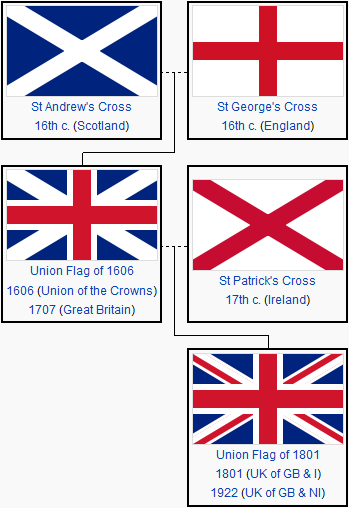
Constituent components of the Union Flag
This is no doubt the feeling that wells up inside those from many African nations, who deliberately adopt the uniquely African tricolour of red, yellow, and green (colours specifically indicative of the pan-African movement). The national flags of: Benin, Burkina Faso, Cameroon,Republic of the Congo, Cote D’Ivoire, Ethiopia, Ghana, Guinea, Guinea-Bissau, Mali, Mozambique, Sao Tome and Principe, Senegal, Togo, and Zimbabwe all adhere to the tri-colour combination with many other nations in Africa having only slight variation on this theme. Within the above group, the only difference between the flags of Ethiopia and Guinea is the orientation of their tri-colour stripes. The only difference between the flags of Guinea and Mali are the order in which the stripes appear. The differences between the flags of Benin, and Guinea-Bissau could form the basis of a “spot the difference test”. Clearly these African nations have no problem making a deliberate choice to display an identity and continuity that reaches beyond their borders into cultural, historical, linguistic, political and religious ties.
It should also be noted that many of the African nations do not eschew their colonial past either. Most notably the flag of Chad, which is a deliberate fusion of the French tri-colour with the Pan-African colours.
In South America we see that the sky blue and white colour, symbolic of the liberation army of General Belgrano, achieve wide application. The national flags of Argentina, Costa Rica, El Salvador, Guatemala, Honduras, Paraguay, and Uruguay all share in this symbolism of revolutionary independence from Spain. Arguably others share this symbolism with an added red colouration such as Panama and Cuba. Within the above group the only difference between the flags of El Salvador and Honduras, to the casual observer, are the 5 stars clustered in the centre of the latter. The only difference, to the casual observer, between the flags of Argentina and El Salvador is the shade of the blue used. Clearly, the nations of South America aren’t shy about celebrating a common community that binds them together in spite of the many wars, conflicts and shifts in borders that have occurred in that region over the decades.
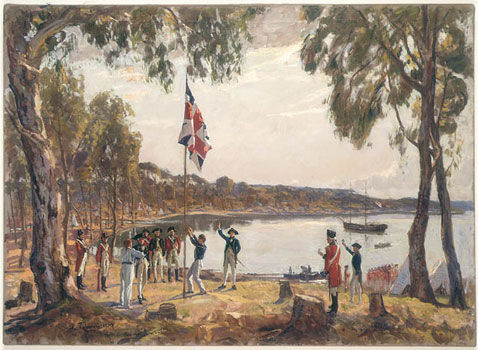
Painting by Algernon Talmage R.A., “The Founding of Australia by Captain Arthur Phillip R.N. Sydney Cove, 26th January 1788”. This painting, which shows the raising of the Union Flag, is on permanent display at the New South Wales State Parliament House, Macquarie Street, Sydney.
The Slavic nations share the colouration of red, white and blue, usually expressed as three horizontal stripes, known as the colours of the Pan-Slavic movement. Indeed Slovakia and Slovenia are separated only by the coat of arms present towards the hoist of their respective flags (and a slight difference in ratio). Serbia only differs from both of them by the order of its colours, and Russia by the absence of its coat of arms. Croatia and Serbia (between whom no love is lost at the diplomatic table) only differ in their national flags by the respective coat of arms presented. The Czech republic is the only flag vaguely distinguished – but she still retains the distinctive Pan-slav colours. Clearly all these nations – despite having a legendary reputation for intra-tribal warfare – are intent upon retaining their broader identity. There does not seem to be any shame on the part of any of the above nations in retaining national flags easily confused by the casual observer.
There are many similar examples from around the world: the use of the crescent by a plethora of nations formerly of the Ottoman Empire or of Turkic descent (Algeria, Azerbaijan,Tunisia, Turkey, Turkmenistan, Uzbekistan), the cruciform of the Scandinavian nations, the “Revolution” tricolour formation on the European continent (Andorra, Belgium, France, Germany, Hungary, Ireland, Italy, Luxembourg, Romania), the colours of Pan-Arab nationalism in the Middle East (Egypt, Iraq, Jordan, Kuwait, Sudan, Syria) and the distinctive green field of Islam (Comoros, Libya, Maldives, Mauritania, Pakistan, Saudi Arabia). From the above examples – picture the flags of Jordan, Kuwait and Iraq upon a podium. Onlookers would instantly register a common theme, and the members of those nations would feel more than just national pride – they would see the result as a “victory for The Middle East” – in spite of their differences and hostilities. In fact, after the invasion of Saddamite Iraq, the new government proposed a change of flag to represent a “new” Iraq. The design involved a very new look – blue and yellow bands at the base with a light-blue crescent against a white field. The reaction among the various Arab peoples (most at war with each other) to the removal of the Pan-Arab colours was so vehement, that the project was abandoned and the old flag retained. they may fight among each other in a bitter civil war – but they all recognise each other as Arabs none-the-less and seek to have their common identity displayed to the outside world.
One of the exceptions to the use of Pan-Arab colours in the Middle East are the flags of Bahrain and Qatar. However, if you were to be asked which of those respective flags was which, when they are placed side by side, you’d only be able to by the shade of red used in the fly half (and dimension ratio if you had a keen and mathematical eye). These two proud and proximate Kingdoms don’t seem to mind the subtlety of the distinction.
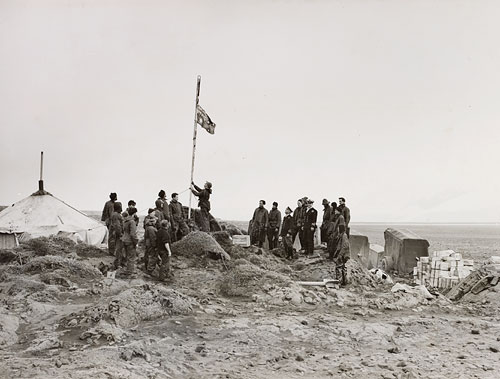
Members of the Australian National Antarctic Research Expedition raising a cheer as Group Captain S.A. Campbell (centre) hoists the Australian flag on Heard Island, 26 December 1947, by unknown photographer (N.S.W. State Library Photo PXE 731/1938)
What is it about the Anglophone world that sees it resile from its cultural heritage and the historical facts that constitute its origins, and indeed bind it together?
Other nations of the world seem prepared to embrace common symbolism blatantly defined by race, religion or political credo. Some flags deliberately seek more than one such identity to be expressed in their national flag. The national flag of Chad adopts the French tricolour and some of the pan-African colours – desiring to reflect its African identity and revolutionary origins whilst not alienating itself from its colonial past.
One can only conclude that the likes of Robert Webster seek to undermine the cultural heritage of this nation and the natural affinity it would have with other members of the Anglo-sphere, in a deliberate act of ideological revolution. This of course is nothing new. Many other nations have utilised dramatic changes in their flag to symbolise successful cultural and/or political revolution. One such example occurs with the flag of Burkina Faso, when in 1984 it dropped the flag adopted upon independence in 1960, reflective of its French colonial past, and adopted the colours of the pan-African movement as part of a deliberate and politically symbolic act of severance from such a past. There are many other examples including the alarming presence of an AK47 assault rifle within the hoist of the national flag of Mozambique.
Is AUSFLAG suggesting that a cultural revolution is afoot? One can predict their retort of “Nationalism”, on the basis that their flag proposals are not so much revolutionary as a natural step in Australia “Coming of age”. Unfortunately, such ideologues are blind to the fact that what they are doing with their embarrassment by Anglo-sphere symbolism, is weakening deeper cultural bonds that are beyond politics and national borders (or at least we hope they are blind to it).
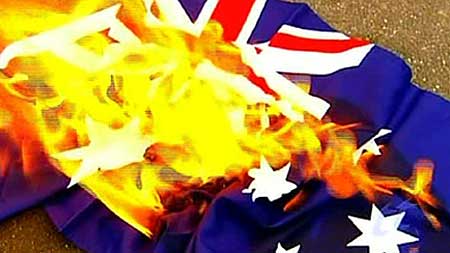
Radical activists routinely desecrate the national flag in a show of self hate. Now, the liberal and so-called ‘progressive’ establishment seeks its own kind of self effacing vandalism: replace the flag with something more ‘contemporary’ and ‘relevant’, something devoid of history, tradition, something deracinated and empty of meaning. Sadly, many of these vandals, such as the National Party’s Robert Webster, are ensconced in our nominal ‘conservative’ lobby today.
One would have thought that a sign of cultural maturity would be confidence with ones origins, history and shared values and the desire to preserve them. Notions of such coming of age are reminiscent of an adolescent fumbling with adulthood and heading cock-sure for one of life’s hard lessons. One worries however, that at the heart of this misguided movement is a more sinister impulse that knows exactly what it is doing. It seeks to deliberately sever the common bonds Australia has with the Anglo-sphere that reach back beyond 1788 and which provide firm bedrock for an organic host culture.
Note should also be made of the ease with which the spiritual significance of the Union Jack is dismissed by these so-called nationalists, who are very much like a child squirming in a pew, itching for playtime three quarters of the way through Mass. The Crosses of St George, St Andrew and St Patrick all reside in the Union Jack providing spiritual backbone to the symbolism of the various nations that form the United Kingdom. By extension, the nations who adopt the Union Jack are also hoisting their recognition of this spiritual inheritance. I can’t help but think it pains those at Ausflag who propose the use of our greatest astronomic feature – the stars of the Southern Cross, to see it resemble, unavoidably, the Christian heritage of this nation. I’m sure that – with revision – they will find a way to make the pattern look “less religious” in the name of “multiculturalism”. The Union Jack is one of the most definite symbols of harmony alive in national flags – to dispense with it, is a statement against co-operation and unity.
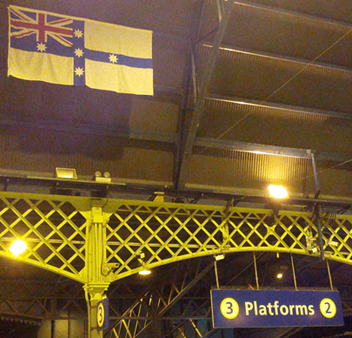
Australia’s historic “Federation Flag”, adopted by the Sydney Traditionalists as our banner, is proudly displayed by authorities at Central Station, Sydney.
What should disturb members of the Anglo-sphere more than anything is the rate at which the Union Jack is disappearing from national flags. If Fiji rids its flag of The Jack, then other than the three flags discussed above, Tuvalu is the only other sovereign nation to bear it (the few remaining Dependancies still retain it, such as Bermuda and The Cayman Islands). Is the current presence of the Union Jack in national symbolism anything other than a pale reflection of the former Empire or even of what would have been regarded as the Anglo-sphere? It seems that the tricolour of the French Revolution has had as much of an impact upon Britain’s former colonies as it has upon her own. The loss of this symbolism heralds the death of an idea and the loss of identity. It shows a profound lack of confidence rather than maturity.
When ‘cultural baggage’ is thrown overboard in the manner described above, the way is made open for ideology to fill the void. The mantra of multiculturalism can be preached far and wide from its minarets. The muezzin call of the self important bureaucrats, both public and private, is a dinner bell to feed from an ideological trough. In pavlovian response, the establishment “conservatives” too, gorge themselves fat upon the sugary delights of Utopic delusion and material advantage. To know and recognise one’s true historic and cultural origins, and to embrace them, is the disposition of the honest and virtuous.
– Luke Torrisi
The author is a legal practitioner and the host of Carpe Diem, Sydney’s only explicitly Traditionalist and Paleoconservative radio programme broadcasting on 88.9FM, between 8:00 to 10:00pm, Mondays.
Notes
- The facts and assertions made are from the authors own knowledge but have been verified for the purposes of publication using Collins Gem Flags (Harper Collins, 1992) and SBS World Guide, 16th ed. (Hardie Giant Books, Prahran, 2008).
- Caption text by SydneyTrads Editors.
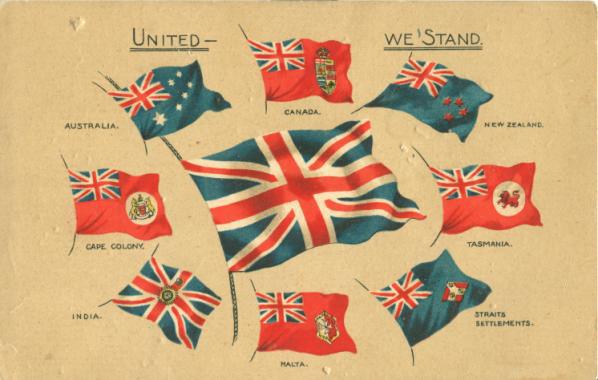
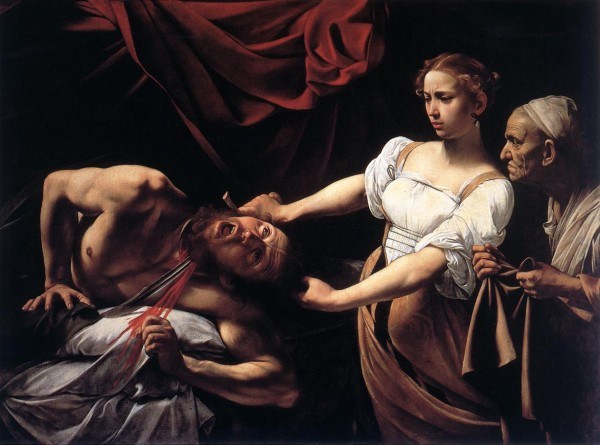
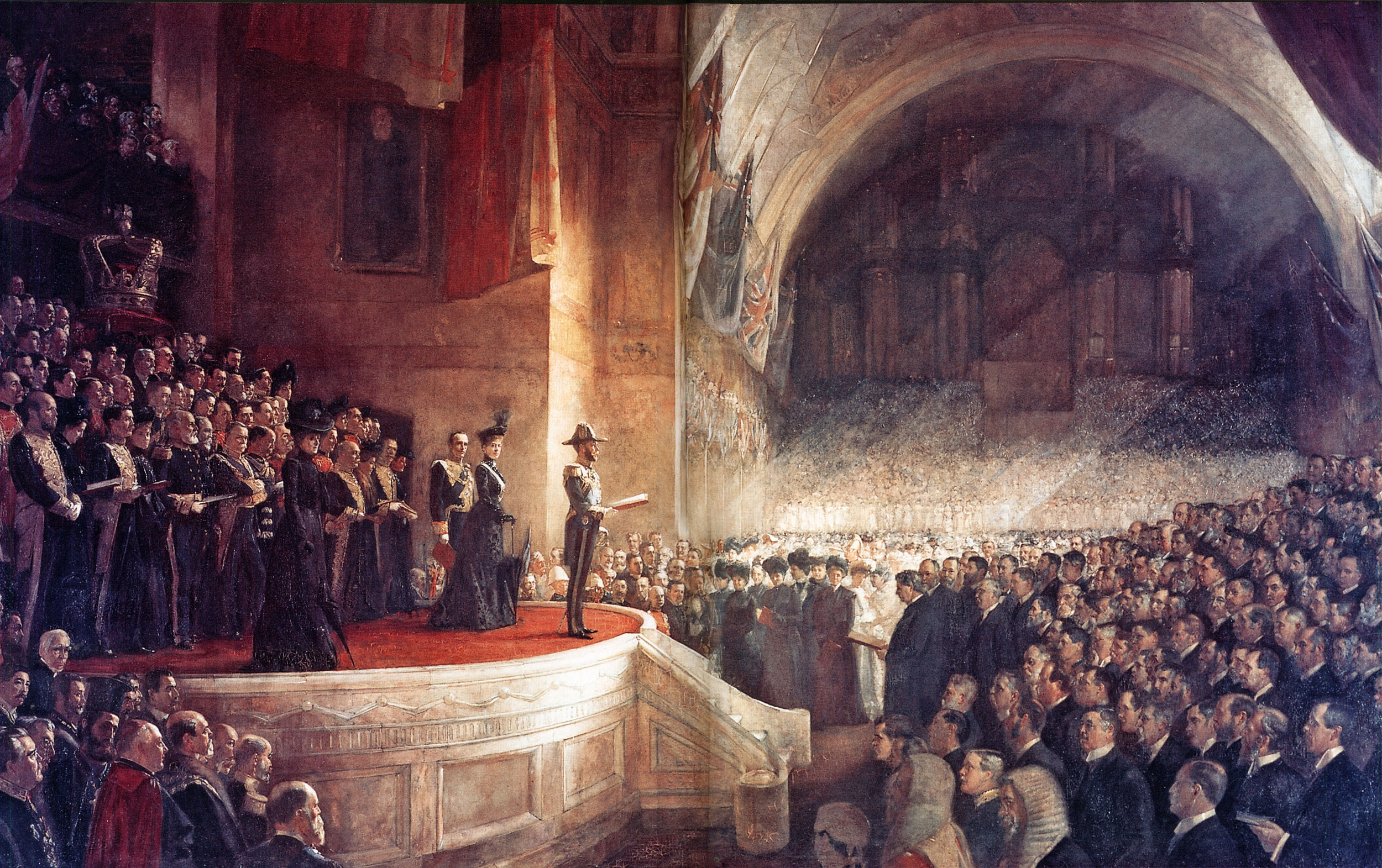


This is a brilliant piece of writing! I found myself nodding all the way through reading it, and desiring ardently that all my compatriots could share these opinions and accept these facts. Australia was, is, and always shall be a Christian nation with its roots deeply entrenched in Great Britain’s grand history. Luke Torrisi expresses these verities in a most admirable, eloquent style.
The war against Anglo Australia:
http://www.amren.com/features/2013/03/what-happened-to-white-australia/
It must be said from the outset: there is certainly a great deal about which to be angry today. Especially as we look upon our leaders squandering our inheritance and patrimony. Anger, if its causes are unaddressed for long enough, can lead to hate. Herein lies a profound danger. Traditionalist Conservatives must be very careful not to fall into the darkness of hate-motivated politics. We must guard against this diligently because hate is a self destructive energy. We are offended almost on a daily basis, but as gentlemen, and sons of the British Empire (even if only spiritually) we must carry the stoic fortitude and uncompromising loyalty to principle that characterised those who ‘came before’.
Nobody can deny that Australia, and of course the entire West, have undergone massive demographic and cultural transformations. Likewise, it cannot be denied that prosperous societies must be stable and socially cohesive. This is required to foster the necessary conditions for the civil society on which wealth acquisition can occur and where cultures can flourish. Research conducted even by agitators for the multicultural left have recently conceded that social capital is lost with increased ‘diversification’. Prof. Robert Putnam’s “E Pluribus Unum: Diversity and Community in the Twenty-first Century The 2006 Johan Skytte Prize Lecture” published in Scandinavian Political Studies 30:2 (2007)* is perhaps the best example of such an admission. The abstract reads as follows:
Oddly, the study avoids the most obvious conclusions, and merely reiterates the doctrine of diversity assuming them to be an unimpeachable social good. Such is the reality denying mindset of the liberal ideologue:
Neither leftists nor libertarians understand this important fact: people are communitarian by nature and their function within society is inextricably tied to their individual and greater identity. This is because a sense of belonging is deeply rooted in our very being. The state policy of a multicultural social-democracy ignores this important aspect of human nature (at least as it applies to people of European descent). Instead, it erodes the dominance of the host culture as well as the particular importance of the society’s foundational population. That is done under the doctrines of ‘diversity’ and ‘multiculturalism’ which, it can now confidently be said, are actually code words for the erasure of traditional identity and the pedestalisation of all things associated with The Other.
Sadly, the resulting trauma caused by the loss of core identity results in fringe reaction, or at least the appearance of fringe reaction: since traditional and refined modes of host cultural expression are thus erased over time, it is more likely that that any reaction will be crass and hostile. This is a product of exacerbated levels of frustration and anxiety on part of the new underclass. That of course is not entirely unwelcome by the ‘progressive’ establishment, since it will happily use examples of such reaction as a vindication of their policies and the apparent evidence for the need of their ever more aggressive execution. This vicious cycle of positive feedback is entirely unsustainable in the long run, but neither of the mainstream political parties seem to care much beyond one or two electoral cycles.
Such is the irony of so-called ‘progressive’ ideologies, which seek to combat ‘bigotry’ but effectively create conditions where it is instigated, provoked and taunted. By enforcing artificial ‘happiness’ and synthetic ‘inclusivity’, they effectively create a system of coerced compliance and managerial tyranny through political correctness, ushering in the era of cynicism, simmering bitterness and the hate that naturally and rapidly follows it. If indeed the left wanted to encourage a stable and benevolent society, they would focus on all those things that go to reinforcing the host culture and the identity of the foundational population. That of course requires a particularise approach to policy, both domestic and foreign, but that is not possible without a fundamental repudiation of 21 Century Western liberalism in both its new-left and neoconservative variants.
The best we can do at present, is lead by example, in honour and dignity.
* [DOI: 10.1111/j.1467-9477.2007.00176.x]
Ethologist Frank Salter:
“The subordination and steady replacement of Anglo Australia is not due to high principle but an unholy Left-minority alliance. The cosmopolitan Left has abandoned the shrinking white blue-collar working class for new constituencies, including minority ethnics who can be relied upon to vote for parties that keep the immigration door open to ethnic kin. Australia’s cosmopolitan elites are, in effect, electing a new people to replace reactionary Anglo Australia. The fact that the new people are more ethnically motivated than Anglo Australians has not bothered ideologues who are on hair-trigger alert for any hint of Anglo ethnic sentiment.”
http://www.quadrant.org.au/magazine/issue/2012/10/the-war-against-human-nature-iii-race-and-the-nation-in-the-media
The question is: why does the “conservative” side of Australian politics support displacement-level immigration? Are they simply just puppets for pro-immigration big business? Or have they embraced the same anti-national, anti-Anglo, anti-white ideology of the Left? Or are they just trying to show how “non-racist” they are? Or all of the above?
EF,
As is often the case, there is no single answer for social and political trends, although some factors may be more dominant at any given moment or issue. Many of your suggested reasons for the poor state of conservative politics indeed do account for the status quo. Be that as it may, it is the conservative electorate that sustains this status quo each electoral cycle. Who therefore ultimately bears the responsibility, and the blame?
More from Salter:
“Anglo Australians are a subaltern ethnicity. They are second-class citizens, the only ethnic group subjected to gratuitous defamation and hostile interrogation in the quality media, academia and race-relations bureaucracy. The national question is obscured in political culture by fallout from a continuing culture war against the historical Australian nation. Many of the premises on which ethnic policy have been based since the 1970s are simply false, from the beneficence of diversity to the white monopoly of racism and the irrelevance of race. The elite media and strong elements of the professoriate assert that racial hatred in Australia is the product of Anglo-Celtic society. But in the same media and even in the Commission for Race Discrimination most ethnic disparagement is aimed at ‘homogenised white’ people.”
Full article:
http://www.quadrant.org.au/magazine/issue/2012/11/the-war-against-human-nature-iii
EF,
We are familiar with Dr. Salter’s work, and consider him to be a friend of the Sydney Traditionalists. We welcome the fact that Quadrant magazine has seen fit to publish his worthy material of late. This is a promising sign of the kind of ‘free thinking’ on the right that will be required for a genuine traditionalist renaissance in Australia. For too long, the nominal right has been dancing to the tune of leftist rhetoric, and allowed its opposition to frame political discourse. A true opposition to leftist politics require an unambiguous repudiation of liberalism per se.